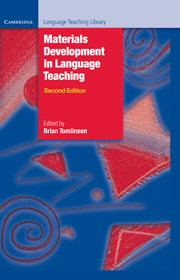Book contents
- Frontmatter
- Contents
- Preface
- Glossary of basic terms for materials development in language teaching
- Acknowledgements
- 1 Introduction: principles and procedures of materials development
- Part A Data collection and materials development
- 2 Using corpora in the language classroom
- 3 Concordances in the classroom without a computer: assembling and exploiting concordances of common words
- 4 Telling tails: grammar, the spoken language and materials development
- Comments on Part A
- Part B The process of materials writing
- 5 A framework for materials writing
- 6 Writing course materials for the world: a great compromise
- 7 How writers write: testimony from authors
- Comments on Part B
- Part C The process of materials evaluation
- 8 The analysis of language teaching materials: inside the Trojan Horse
- 9 Macro- and micro-evaluations of task-based teaching
- 10 What do teachers really want from coursebooks?
- 11 The process of evaluation: a publisher’s view
- Comments on Part C
- Part D The electronic delivery of materials
- 12 Developing language-learning materials with technology
- 13 New technologies to support language learning
- Comments on Part D
- Part E Ideas for materials development
- 14 Seeing what they mean: helping L2 readers to visualise
- 15 Squaring the circle – reconciling materials as constraint with materials as empowerment
- 16 Lozanov and the teaching text
- 17 Access-self materials
- Comments on Part E
- Conclusions
- Recommended reading
- Index
7 - How writers write: testimony from authors
Published online by Cambridge University Press: 09 February 2023
- Frontmatter
- Contents
- Preface
- Glossary of basic terms for materials development in language teaching
- Acknowledgements
- 1 Introduction: principles and procedures of materials development
- Part A Data collection and materials development
- 2 Using corpora in the language classroom
- 3 Concordances in the classroom without a computer: assembling and exploiting concordances of common words
- 4 Telling tails: grammar, the spoken language and materials development
- Comments on Part A
- Part B The process of materials writing
- 5 A framework for materials writing
- 6 Writing course materials for the world: a great compromise
- 7 How writers write: testimony from authors
- Comments on Part B
- Part C The process of materials evaluation
- 8 The analysis of language teaching materials: inside the Trojan Horse
- 9 Macro- and micro-evaluations of task-based teaching
- 10 What do teachers really want from coursebooks?
- 11 The process of evaluation: a publisher’s view
- Comments on Part C
- Part D The electronic delivery of materials
- 12 Developing language-learning materials with technology
- 13 New technologies to support language learning
- Comments on Part D
- Part E Ideas for materials development
- 14 Seeing what they mean: helping L2 readers to visualise
- 15 Squaring the circle – reconciling materials as constraint with materials as empowerment
- 16 Lozanov and the teaching text
- 17 Access-self materials
- Comments on Part E
- Conclusions
- Recommended reading
- Index
Summary
Introduction
This chapter looks at the process of materials writing from the writer’s perspective. It uses two snapshots: one taken in 1994 and one taken 15 years later.
A group of ELT materials writers from all over the world met in Oxford in April 1994 for a British Council Specialist Course with UK-based writers and publishers. The personal accounts of the writing process, which make up the first and longer part of this chapter, are taken from questionnaires and correspondence with course participants and tutors, and their friends. The accounts are presented as they were written, and are grouped thematically. With technological progress some aspects of the accounts have dated, but they have been retained both out of historical interest and in order to preserve the integrity of the original. Equally references to ‘new’ developments are to be read in the understanding that they were new in 1994 rather than now. I owe a deep debt of gratitude to the contributors to this first section for allowing me to reproduce their responses anonymously. The contributors are: Wendy Ball (UK), Jan Bell (UK), Elisabeth Fleischmann (Austria), Judy Garton-Sprenger (UK), Ram Ashish Giri (Nepal), Simon Greenall (UK), Shamsul Hoque (Bangladesh), Marina Larionova (Russia), Tony Lynch (UK), Peter May (Belgium), Ian McGrath (UK), Olga Nikolaeva (Russia), Ruxandra Popovici (Romania), Naina Shahzadi (Bangladesh), Keith Tong Sai-tao (Hong Kong), Catherine Walter (UK).
Fifteen years later four leading ELT materials writers were asked to read the chapter and to refl ect on their own practice. They were: Jeremy Harmer (author of the Just Right series, Marshall Cavendish), Sue Kay (co-author of the Inside Out series, Macmillan), Pete Sharma (author of Blended Learning: Using Technology in and beyond the Language Classroom , Macmillan), and Jeff Stranks (co-author of the English in Mind series, Cambridge University Press). Their refl ections form the second part of this chapter, with three of them focusing on the writing process, and the fourth, Sharma, on the impact of technology on writing.
Writers’ perspectives in 1994
Writing together
Most of the contributors have written at some time, or always, as a member of a team. Their accounts of collaborative writing highlight the importance of team-building, as well as divergences in working practice.
- Type
- Chapter
- Information
- Materials Development in Language Teaching , pp. 151 - 173Publisher: Cambridge University PressPrint publication year: 2011
- 12
- Cited by



